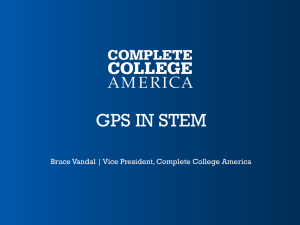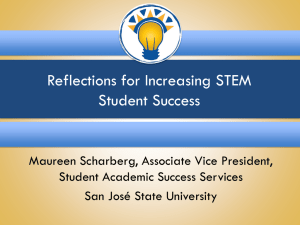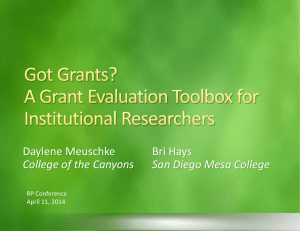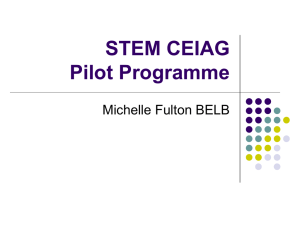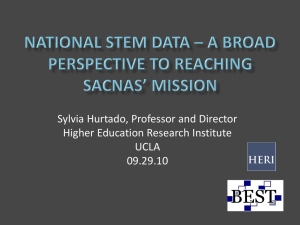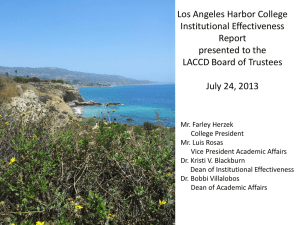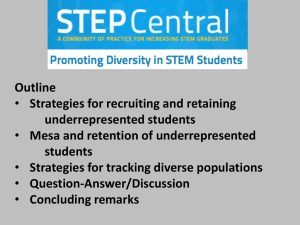(STEM) focused high schools. - National Association for Research in
advertisement
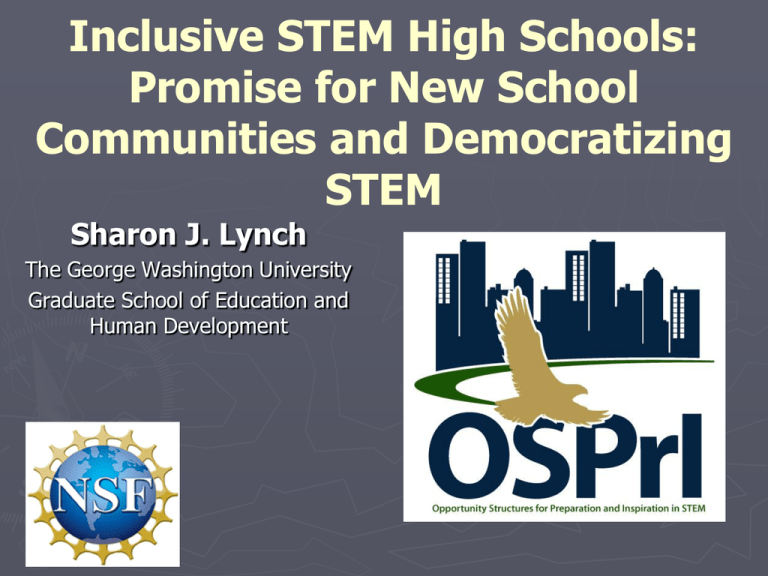
Inclusive STEM High Schools: Promise for New School Communities and Democratizing STEM Sharon J. Lynch The George Washington University Graduate School of Education and Human Development Opportunity Structures for Preparation & Inspiration (OSPrI): A Cross-case Analysis of Inclusive STEMfocused High schools Co-PIs ► Tara Behrend, George Washington U ► Erin Peters Burton, George Mason U ► Barbara Means, SRI International Research Staff, GWU ► Kathleen Ross ► Nancy Spillane ► Mike Ford ► Ed Han ► Sam Kaminsky What is STEM education? A Good Definition of STEM Education “…an interdisciplinary approach to learning where rigorous academic concepts are coupled with realworld lessons as students apply science, technology, engineering, and mathematics in contexts that make connections between school, community, work, and the global enterprise enabling the development of STEM literacy and with it the ability to compete in the new economy” (Tsupros, Kohler, & Hallinen, 2009). ► Attracting the attention of political leaders, business and industry, philanthropy and NGOs. ► STEM literacy for all. What is an Inclusive STEM-Focused School? Inclusive STEM-focused High Schools ISHSs: ► Self-identify as STEM schools. ► Are schools of choice with specific missions to increase participation of groups under-represented in STEM. ► Have “open” admissions, lottery, few requirements. ► Provide high quality STEM learning experiences for students, with support systems for success. ► Link local economies, communities, and colleges/universities: community involvement in conception and delivery. OSPrI: Importance of Study This study is important because: ► Encouraged by President Obama and the White House. ► ISHSs are included in several state plans (OH, NC, TX, WA, and TN). ► But, the ability of ISHSs to prepare new learners ready for college STEM majors and careers not been well documented. ► There is no umbrella philosophy or organizational structure for ISHSs. ► But a companion ISTEM study (Means et al.) is in progress that explores the impact of ISHSs in NC. Opportunity Structure Model Proposed by Kenneth Roberts (1968) ► Theories of career development that held that hard work and good choices determined job choices and success. ► Roberts’ research: Geographic and social proximity determines access to different types of employment. ► AHA! STEM schools intentionally build opportunity structures and expand students’ possibilities for jobs and careers as they contribute to the quality of STEM learning. This is win/win for students. ► This is why they are exciting. ► ISHSs Build Opportunity Structures, Purposefully The choice is not “school OR work”; rather it is “school and work” – mentors and projects build social capital. ► Develop students’ cognitive assets, especially in STEM. ► Develop non-cognitive factors, enhancing 21st century skills. ► Enhance students’ contacts and experiences to produce (more) social capital. Research Questions ► Is there a core set of critical components implemented in well-established, promising ISHSs? Do other critical components emerge? ► Is there a model that captures the critical components? (A model would contribute to understanding the feasibility of scale-up and sustainability.) Candidate Critical Components: Creating Opportunities in ISHSs 1. STEM-focused curriculum 2. Reform instructional strategies & Project-based learning 3. Integrated, innovative technology use 4. Blended formal/informal learning beyond the typical school day, week, or year 5. Real-world STEM partnerships 6. Early college-level coursework 7. Well-prepared STEM teaching staff 8. Inclusive STEM mission 9. Administrative structure 10. Special supports for under-represented students How are the 10 Critical Components designed into and implemented in each STEM School? ►Select 12 “wellestablished” STEM schools. ►Look for 10 “suspected” critical components, but capture other important elements and variations in context. ►Conduct cross-case analyses to define common model. Highly Diverse: Demographics of 3 OSPrI Study Schools (% Female, African-American/Black, Hispanic, White, Asian, Economically Disadvantaged/Free and Reduced Lunch Eligible) State School Texas North Carolina Colorado “Exemplar” OSPrI study schools in 3 states: Student Outcomes Percent Proficient on State Assessments Outcomes • Colorado school: 100% • Texas school achieved of students admitted to 100% college admission college—most to 4-year rate in 2012 with 65% colleges (60% of of graduates “first students are African generation” to attend American or Latino/a). college”. • Rural North Carolina school achieves higher college admissions rates than nearby schools, despite lack of resources. How do ISHSs accomplish this? Cognitive Factors ► More STEM coursework during high school, or fast-tracking through high school to take college courses. ► Instructional Practices range from 100% project-based learning to traditional mastery learning aimed at college success. ► Dedicated, qualified STEM teaching staff provide more instructional hours in targeted and innovative ways. Non-cognitive Factors~ 21st Century Skills ISHSs create/develop: ► Flattened hierarchies between students, teachers and knowledge through project-based learning, ubiquitous technology use, and early college enrollment. ► School data systems involve both students and parents. ► Character and values developed. Students pride themselves on inclusive environment for all. Opportunity Structures that Enhance Social Capital ► Mentoring systems, community-based STEM experiences; long-range contextualized challenge projects. ► College admissions honed. Students empowered to grow STEM identities through a succession of increasingly challenging, successful experiences in school and community. ► Horizons for education, careers and life expand. Insights and Policy Implications Insights ► ► ► ► ► ISHSs are broadening the notion of school community in innovative ways, affecting cognitive and non-cognitive factors. ISHSs deliberately create opportunity structures not typically available through families, neighborhoods, or community paths. Families are involved. This is not a deficit model but an opportunity model. If a student graduates, she/he is going to college, or already part way through college. ISHSs democratize STEM for students; the message to community is that under-represented students can do STEM with great success and are a valuable resource. Policy Implications ► Inclusive STEM high schools are test beds for STEM innovations; innovative and flexible. ► While ISHSs are few, they are powerful examples of what regular students interested in STEM can do when opportunity structures are deliberately built into schools using expansive notions of school community. ► ISHSs can aid local economies AND reduce inequalities. These are not only twin goods, they are inter-dependent. The End Website: http://ospri.research. gwu.edu/about References ► ► ► ► ► ► ► ► ► ► ► Carnegie Corporation (2009). The opportunity equation: Transforming mathematics and science education for citizenship and the global economy. New York: Author. Larmer, J. (2009). PBL starter kit. Buck Institute for Education. p. 4 Lynch, S.J., Means, B., Berhend, T. & Peters Burton, E. (2011). Multiple Instrumental Case Studies of Inclusive STEM-focused High Schools: Opportunity Structures for Preparation and Inspiration (OSPrI) Means, B., Confrey, J., House, A., & Bhanot, R. (2008). STEM high schools: Specialized science technology engineering and mathematics secondary schools in the U.S. (Bill and Melinda Gates Foundation Report). Retrieved from National High School Alliance website: http://www.hsalliance.org/stem/index.asp New Tech High Foundation. (2010). New tech network. Retrieved from http://www.newtechnetwork.org/ NRC, (2011). Successful STEM Education. Washington, DC: National Academies Press. Obama, B. (2010, September 16). Remarks by the President at the announcement of the “Change the Equation” Initiative. Available at http://www.whitehouse.gov/the-pressoffice/2010/09/16 Scott, C.E. (2009). A comparative case study of characteristics of science, technology, engineering, and mathematics (STEM) focused high schools. Retrieved from Proquest (AAT 3365600 Subotnik, R., Tai, R. & Almarode, J. (2011). Study of the Impact of Selective SMT High Schools: Reflections on Learners Gifted and Motivated in Science and Mathematics . Tsupros, N., R. Kohler, and J. Hallinen, 2009. STEM education: A project to identify the missing components, Intermediate Unit 1 and Carnegie Mellon, Pennsylvania Young, V., Adelman, N., Cassidy, L., Goss, K., House, A., Keating, K., et al. Evaluation of the Texas High School Program. Third comprehensive annual report. Austin, TX: Texas Education Agency.
